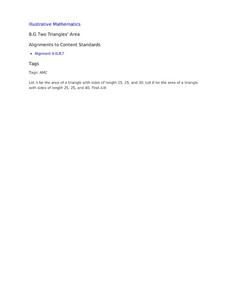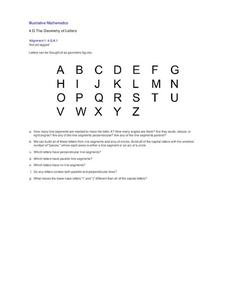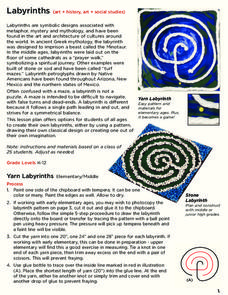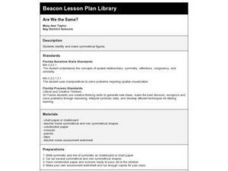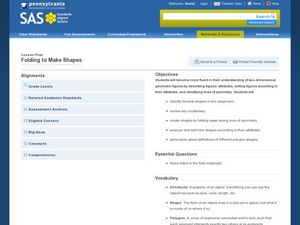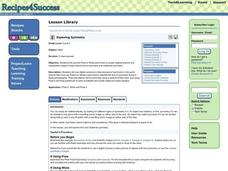Curated OER
Symmetry
Students explore symmetry. In this geometry lesson, student identify and define bilateral symmetry, radial symmetry, pentagonal symmetry, hexagonal symmetry, and cubic symmetry. Students construct examples of these types of symmetry and...
Curated OER
Shaping the View: Symmetry and Balance
High schoolers view an image from the Metropolitan Museum of Art and identify the focal point of the painting. They discuss symmetry and balance as it pertains to the images. Students use the Student LaunchPad (linked to this activity)...
Curated OER
"Polly"gon Pockets
Explore polygons with your elementary learners. Divide the class in 12 to configure the polygon puzzle before them. They list the attributes of each type of polygon they see, and if there's time, they jump on the interactive website...
Curated OER
Draw the Other Half
How can you make the two halves symetric? Scholars use the concept of symmetry to complete five images which are only half-drawn. The fun part about this exercise is that they aren't copying geometric shapes. There is a face, sun, kite,...
CK-12 Foundation
Even and Odd Functions and Function Symmetry: Even and Odd Functions (Symmetry)
Even money states that the resource is good to use. Scholars manipulate an interactive to adjust the portion of a graph to the left of the y-axis. The interactive allows them to switch between even and odd modes that show the right side...
Curated OER
Two Triangles' Area
Need an activity for teaching the Pythagorean Theorem? Geometry juniors apply the Pythagorean theorem to two triangles to determine a final calculation.
Illustrative Mathematics
The Geometry of Letters
Use the alphabet as a tool for teaching your class about geometric figures. Break apart capital letters into line segments and arcs. Classify angles as right, acute, or obtuse. Identify parallel and perpendicular lines. An excellent...
Curated OER
Labyrinths
Whether studying metaphors or Greek mythology, this labyrinth project is a fantastic lesson plan to add to your unit. It includes two versions of the labyrinth; making it with yarn or stone. If your materials are limited, you can even...
Curated OER
Are We the Same?
Students define and discuss symmetry, line of symmetry, and congruency. They cut shapes out of construction paper, identify the line of symmetry, and if they are symmetrical and/or congruent.
Curated OER
Symmetry in Shapes and Everyday Objects
Fifth graders discover lines of symmetry for shapes and everyday objects. In this lines of symmetry lesson plan, 5th graders use a butterfly outline to find lines of symmetry. Students analyze everyday objects for symmetry and use...
Curated OER
Symmetrical Designs with Pretzels and Marshmallows
Fifth graders create designs that have lines of symmetry using pretzel and marshmallows. In this symmetry design lesson plan, 5th graders work in groups using graph paper, rulers, and toothpicks to plan their own lines of symmetry...
Curated OER
A Wall of Symmetrical Shapes
Students explore line(s) of symmetry in polygons during a hands-on activity and a Student Web Lesson. They build a wall of symmetrical shapes designed and drawn by students.
Curated OER
Symme"tree"
Students practice drawing lines of symmetry after the teacher draws shapes on the board. They create a class symme"tree" using only symmetrical shapes to decorate it.
Curated OER
Folding to Make Shapes
Second graders identify different polygons and their attributes. In this geometry instructional activity, 2nd graders get to know polygons by studying the vocabulary and finding polygons in their classroom. They create these shapes and...
Curated OER
Pyramids
In this pyramids worksheet, 10th graders solve and complete 4 different types of problems. First, they count the number of blocks shown in the pyramid. Then, students count the blocks along the lines of symmetry only. They also calculate...
Curated OER
Polygons
In this polygons worksheet, 10th graders solve and complete 27 various types of problems. First, they determine how many lines of symmetry a square has and if it is a parallelogram. Then, students find the number of lines of symmetry in...
Curated OER
Symmetric Snowflake
For this pattern block symmetry worksheet, students analyze one half of a snowflake design. Students cover the design with pattern blocks and complete the design so that the dotted line is a line of symmetry.
Curated OER
Triangles and Quadrilaterals
In this triangles and quadrilaterals worksheet, 10th graders solve 6 different problems related to using triangles and quadrilaterals in informal geometry. They determine how many lines of symmetry an equilateral triangle and an...
Curated OER
Graphs of Quadratic Equations
In this graphs of quadratic equations instructional activity, 9th graders solve and complete 9 different types of problems. First, they find the x- and y-intercept of each equation by using the quadratic formula. Then, students find the...
Curated OER
Reflections of Symmetry
Students use video and the Internet to identify examples of bilateral and radial symmetry in the world around them. They create symmetrical reflection designs using pattern blocks and paper.
Curated OER
Exploring Symmetry
Young scholars use a software program to create artwork and to manipulate images to study mirror and rotational symmetry. They take pictures of items in their environment in which they identify symmetry.
Curated OER
Symmetry Monsters
Students discuss and study the word symmetry. They examine letters of the alphabet, shapes, and artwork and decide if they are symmetrical or not. Then they create their own symmetry monsters.
Curated OER
Symmetry in My World
Second graders demonstrate understanding of symmetry and identify objects that have symmetry. They use a mirror to get a visual illustration of what symmetry is. They create a collage of symmetrical pictures they find in magazines.
Curated OER
Equilateral Triangle Symmetries Closure Activity
Students explore the symmetries of an equilateral triangle. In this lesson on symmetry, students determine the composition of given equilateral triangles using both rotational and reflectional symmetries.







